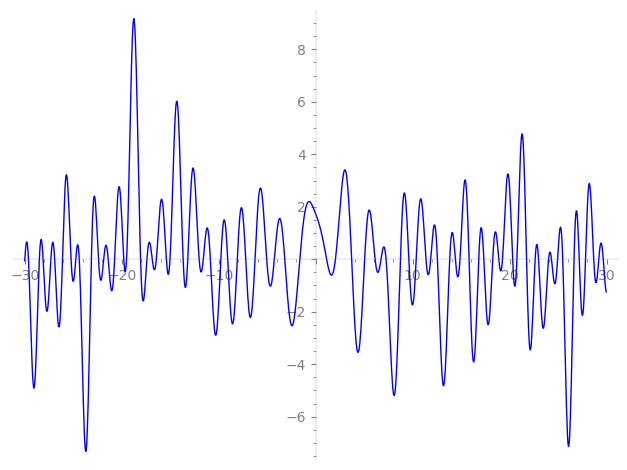| L(s) = 1 | + (−0.675 + 1.17i)3-s + (1 + 1.73i)4-s + (0.5 − 0.866i)5-s + 7-s + (0.586 + 1.01i)9-s + 5.17·11-s − 2.70·12-s + (−1 − 1.73i)13-s + (0.675 + 1.17i)15-s + (−1.99 + 3.46i)16-s + (−0.351 + 0.609i)17-s + (1.91 − 3.91i)19-s + 1.99·20-s + (−0.675 + 1.17i)21-s + (2.76 + 4.78i)23-s + ⋯ |
| L(s) = 1 | + (−0.390 + 0.675i)3-s + (0.5 + 0.866i)4-s + (0.223 − 0.387i)5-s + 0.377·7-s + (0.195 + 0.338i)9-s + 1.55·11-s − 0.780·12-s + (−0.277 − 0.480i)13-s + (0.174 + 0.302i)15-s + (−0.499 + 0.866i)16-s + (−0.0853 + 0.147i)17-s + (0.438 − 0.898i)19-s + 0.447·20-s + (−0.147 + 0.255i)21-s + (0.575 + 0.997i)23-s + ⋯ |
\[\begin{aligned}\Lambda(s)=\mathstrut & 665 ^{s/2} \, \Gamma_{\C}(s) \, L(s)\cr =\mathstrut & (0.238 - 0.971i)\, \overline{\Lambda}(2-s) \end{aligned}\]
\[\begin{aligned}\Lambda(s)=\mathstrut & 665 ^{s/2} \, \Gamma_{\C}(s+1/2) \, L(s)\cr =\mathstrut & (0.238 - 0.971i)\, \overline{\Lambda}(1-s) \end{aligned}\]
Particular Values
| \(L(1)\) |
\(\approx\) |
\(1.35581 + 1.06319i\) |
| \(L(\frac12)\) |
\(\approx\) |
\(1.35581 + 1.06319i\) |
| \(L(\frac{3}{2})\) |
|
not available |
| \(L(1)\) |
|
not available |
\(L(s) = \displaystyle \prod_{p} F_p(p^{-s})^{-1} \)
| $p$ | $F_p(T)$ |
|---|
| bad | 5 | \( 1 + (-0.5 + 0.866i)T \) |
| 7 | \( 1 - T \) |
| 19 | \( 1 + (-1.91 + 3.91i)T \) |
| good | 2 | \( 1 + (-1 - 1.73i)T^{2} \) |
| 3 | \( 1 + (0.675 - 1.17i)T + (-1.5 - 2.59i)T^{2} \) |
| 11 | \( 1 - 5.17T + 11T^{2} \) |
| 13 | \( 1 + (1 + 1.73i)T + (-6.5 + 11.2i)T^{2} \) |
| 17 | \( 1 + (0.351 - 0.609i)T + (-8.5 - 14.7i)T^{2} \) |
| 23 | \( 1 + (-2.76 - 4.78i)T + (-11.5 + 19.9i)T^{2} \) |
| 29 | \( 1 + (1.85 + 3.20i)T + (-14.5 + 25.1i)T^{2} \) |
| 31 | \( 1 - 3.82T + 31T^{2} \) |
| 37 | \( 1 + 2.82T + 37T^{2} \) |
| 41 | \( 1 + (4.08 - 7.07i)T + (-20.5 - 35.5i)T^{2} \) |
| 43 | \( 1 + (4 - 6.92i)T + (-21.5 - 37.2i)T^{2} \) |
| 47 | \( 1 + (3.49 + 6.05i)T + (-23.5 + 40.7i)T^{2} \) |
| 53 | \( 1 + (-2.41 - 4.17i)T + (-26.5 + 45.8i)T^{2} \) |
| 59 | \( 1 + (2.82 - 4.89i)T + (-29.5 - 51.0i)T^{2} \) |
| 61 | \( 1 + (-2.52 - 4.37i)T + (-30.5 + 52.8i)T^{2} \) |
| 67 | \( 1 + (5.82 + 10.0i)T + (-33.5 + 58.0i)T^{2} \) |
| 71 | \( 1 + (-0.413 + 0.716i)T + (-35.5 - 61.4i)T^{2} \) |
| 73 | \( 1 + (-5.84 + 10.1i)T + (-36.5 - 63.2i)T^{2} \) |
| 79 | \( 1 + (-1.93 + 3.35i)T + (-39.5 - 68.4i)T^{2} \) |
| 83 | \( 1 + 83T^{2} \) |
| 89 | \( 1 + (-4.26 - 7.38i)T + (-44.5 + 77.0i)T^{2} \) |
| 97 | \( 1 + (-4.87 + 8.44i)T + (-48.5 - 84.0i)T^{2} \) |
| show more | |
| show less | |
\(L(s) = \displaystyle\prod_p \ \prod_{j=1}^{2} (1 - \alpha_{j,p}\, p^{-s})^{-1}\)
Imaginary part of the first few zeros on the critical line
−10.85916950659726165772674206196, −9.782489682407259864431691330564, −9.071634547941162552709949619402, −8.084858272923133752884982285331, −7.21682324352628313418196066245, −6.25889617449958587570387990645, −5.05335202002362261970458141249, −4.26807698214335605336871959369, −3.18964867804754293255362322908, −1.64414928021479718420897213953,
1.12174822512070078898066327636, 2.02994869980025784886523812867, 3.70281177899608783973360560580, 5.04132452468578451201922401357, 6.12217054302690278921154839684, 6.72833433249717229857829809153, 7.25132223526524975865937485074, 8.729091166602708194184200045242, 9.598524599242189191034964555744, 10.35737301052584921855618713844

